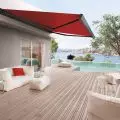The achievements of the Polish avant-garde of the first half of the 20th century inspire the principles of preservation, continuation and development of architecture.
Reconstruction of the country a chance to realize innovative architecture
In the 1920s, the modernist revolution in art and architecture in the world coincided with the reconstruction and dynamic development of the Polish state, which, after regaining independence, gave artists hope for the realization of innovative projects.
Filled with energy, artists began to struggle for a new shape of art. At that time, among many, Katarzyna Kobro and Władysław Strzemiński came to Poland. With their work, publications and participation in artistic life, they tried to bring new values to art. However, there was chaos and program confusion, the mainstream did not crystallize. Of great importance was the helplessness of the critics of the time in understanding avant-garde works, who depreciated Polish modernism by presenting it as "an anemic current, aimless and dull"1.
Kobro and Strzeminski were initially active in the "Zwrotnica" and "Blok" groups, then in the Praesens group together with architects B. Lachert, J. Szanajca and Sz. Syrkus. Their interests focused on the search for a universal principle of composing space.
"a.r." - actual avant-garde
In 1929, as a result of personal antagonisms and programmatic differences, Strzeminski and Kobro leave Praesens and found the group "a.r." They recognized the previous contributions of Zwrotnica, Blok and Praesens to the foundations of new art, but at the same time blamed "the disorder of artistic life and superficial modernist epigonism, which lowered the revolutionary significance of new art" and "dulled the sensitivity of the general public to new beauty." Members of the "a.r." group declared a ruthless "fight against oldism, the falsification of artistic values, the senile withering of pseudo-modernists. "2 After such a manifesto, they doomed themselves to solitude. Without the support of the community, in the absence of continuators, it is difficult to break through with the proclaimed concepts. Critics remained silent or simplified and distorted the meaning of their works. For a very long time their achievements remained in the shadows. They found themselves in the depository of history. It is worth discovering this treasure and taking up as a legacy of the avant-garde of Polish modernism.
Approach to architecture
The architects of the Praesens group conducted their studies of architecture in the perspective of implementation and construction practice. Strzeminski and Kobro as the "real avant-garde" went further. They did not focus on the building, its mass and materials3. Inspired by the views of Syrkus, they recognized that modernism - stemming from the dynamism of the "machine age" or "letting everything go" - leads to the breakdown of the solid, which cannot enclose space and should be bursting with the energy of function and the vital rhythm of the user4.
K. Kobro - Spatial Composition
photo: Paweł Wład Kowalski
An approach to heritage
Syrkus and Strzeminski were seekers of a new order in architecture, which they sought by delving into the past. Strzeminski analyzed painting, sculpture and architecture of each era, bringing out their synthesis. He followed the process of their development and from this he derived concepts for the future. He carried out an interpretation of the development of art as stages of enrichment and refinement of "visual consciousness, shaped by the real conditions of existence," which determines "the scope and quantity of vision." It is surprising that, as a representative of the radical avant-garde, he did not preach that the past should be thrown into the dustbin of history and everything should start anew. On the contrary.
Szymon Syrkus also proclaimed as early as 1925 that "the most modern artist will not be the one who creates according to the canons of classicism, or according to futuristic formulas, but the one who, having picked up the thread dropped by the priests of Egypt, by the monks of Romanesque monasteries, by the builders of Gothic cathedrals, by Bruneleschi, Michelangelo, Blondel, Corazzi, Marconi, will deeply understand the latest plastic achievements andwill create new forms, using the possibilities of modern technology (....) Not that which has appearances (....) After the external modernist ornaments are reflected, a naked, clumsy skeleton will remain, with nothing of modernity in it, just as after the external Baroque or Empire ornaments are reflected, a naked and clumsy skeleton will remain, with nothing of classicism in it. For from ancient times to the present day, the greatest and riskiest plastic achievements have been grafted onto the ever-living trunk of great classical architecture, bearing excellent fruit even after the greatest deviations."5
Sh. Syrkus publishes the following text inspiring the innovative concepts of the avant-garde in 1926: "Thearchitectural work melts with the surrounding space.(...) The functionalism of the space, penetrating into the building, is a kind of note. In every building, everyday life is played out according to this score. (...) The architecture of past eras enclosed space in a solid. (...) The modern technique gives the architect the opportunity to launch the elements that make up the solid, allows even their partial removal. The open interior, thanks to the activation of the shutters, will melt into a single whole with the surrounding space. In this way, the traditional closed cuboid of the building ceases to exist. "6
Principles of new architecture
Still working together in the Praesens group in 1928, Syrkus and Strzeminski set forth the principles of the new architecture, making a historical argument about the understanding of the solid in architecture. They singled out classicism as the period encompassing solid architecture - that is, all that came before cubism, followed by constructivism, suprematism, purism - to conclude that "the latest architectural laws no longer juxtapose or bind solids together. By opening it up to space, they shatter the solid irrevocably. "7 Here we have the problem of interpreting what they meant, perhaps each something different.
K. Kobro "Functionalism" 1936 and K. Kobro, W. Strzeminski "Composition of Space. Calculations..." Łódź 1931
compilation and editing by Paweł Wład Kowalski
K. Kobro - composition of space 1932; K. Kobro - design of functional kindergarten 1932.
photo: Pawel Wlad Kowalski
Turning to CIAM and foreign authorities
Szymon Syrkus was appointed in mid-1928 as a representative of the Polish CIAM(Le Congrès International d'Architecture Moderne - International Congress of Modern Architecture) group. This caused the Praesens group of architects to transform into a congress working group, and from then on Strzeminski and Syrkus' paths began to diverge. In 1929 Syrkus participated in the CIAM congress in Basel (along with Le Corbusier, K. Moser, S. Giedion, E. May...). It seems that Polish architects restrained by economic backwardness, jealously looking at the possibilities of the West as if involuntarily submitted to its influence, recognized its superiority, succumbed to the strength of the arguments of foreign realizations, at which the theories of the Polish avant-garde had only the weight of paper and wood mock-ups.
Praesens architects cosmopolitanly blended into the European family of architectural creators, recognizing that the avant-garde was outside Poland. Still Sz. Syrkus, seeing his colleagues' fascination with construction technology, house factories, feared a stagnation of creative thought, as Helena Syrkus recalls8. Especially gifted with a broad imagination, Strzeminski - a Pole born in the East - did not accept such views. It stung his ambitions and his belief in the pioneering value of native, original creative ideas. At the time, he and Kobro were already working on a "computational system of spatial phenomena. "9 He was developing the theories he had previously worked on with Sirkus. It is worth mentioning that the educational program implemented by Strzeminski and Kobro in 1926-31 at the Industrial and Commercial School in Koluszki was rated higher than the Bauhaus program by the editors of Architecture and Construction.10
Criticism of Le Corbusier's work
In 1929 there was ready a book of theirs entitled "Composition of Space. Calculations of space-time rhythm." With its publication in 1931 came a text sharply criticizing the Praesens group and its idol Le Corbuisier. Strzeminski did not recognize his five principles of modern architecture: columns, flat roofs-gardens, free projection, elongated window, free elevation. He stated: "architecture that initiates the rhythm of modern life, should be opposed to the compromised architecture of Le Corbusier and his epigones (most of the new German architects, Swiss architects, architects of the Praesens group and Others), because (...) as a result of the lack of a unified architectural concept, utilitarianism, plasticity and construction are not related to each other." Thus, he upheld Vitruvius' 3 principles (permanence, utility, beauty), which he and Sircus had earlier recognized as the basic foundation of the new architecture. In the principles of the new architecture he promulgated, he criticized Corbuisier's substitution of composition for rhythm - composing"from nothing 'beautiful corners'".He stated that "the operation of a straight line, a flat roof and uninterrupted strips of standardized windows does not yet constitute a solution to modern architecture. "11 He rejected the composition of the solid in favor of a composition that connects with space. After such a text and statements that "conscious shaping of space is absent in their works "12 he has already definitively doomed himself to isolation in the architectural community. Turning away from him meant that "a.r." without architects could not build, realize objects according to the principles created. The ideas initiated and, according to Strzeminski, abandoned by Praesens, remained only on paper. The "a.r." group was relegated to the sidelines, and the originally Polish, world-precursor concepts of the principles of composing space remained in the shadows.























































